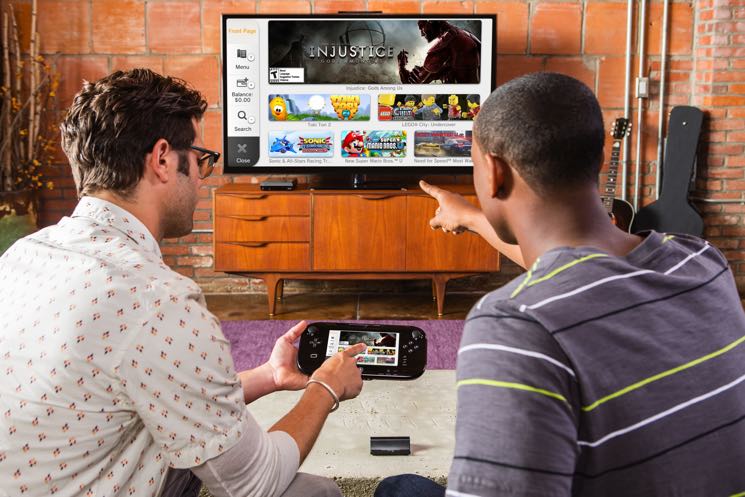You wouldn't know it from all the people hunting Pikachus and Jigglypuffs around your neighbourhood with Nintendo's augmented-reality smartphone game Pokémon GO, but the Mushroom Kingdom is still under siege.
Synonymous with home gaming since the original NES invaded living rooms three decades ago, Nintendo followed its unexpected 100 million-selling Wii victory with the Wii U's undeserved defeat during this round of the perpetual console war.
So the House That Mario Built is throwing a Hail Mary into the next-gen with the March 2017 arrival of a new console, code-named NX. Not that they had a choice: The underrated Wii U has sold less than 13 million to the PS4's 40+ million and the Xbox One's 20 million.
Though they chose not to reveal their new machine at June's E3 gaming conference in L.A., Nintendo of America boss Reggie Fils-Amié did tell Bloomberg, "For us, it's not about specs, it's not about teraflops, it's not about the horsepower of a particular system. For us, it's about the content."
Regarding the PS4 Neo and Xbox One Scorpio console upgrade announcements, he added, "Whatever Microsoft and Sony are doing in terms of talking about new systems, that's for them to fight out in that red ocean."
The reference indicates a return to Nintendo's "blue ocean" Wii strategy, which attracted millions of non-traditional gamers to the medium rather than battling competitors in bloody waters over the hardcore crowd.
Though a lesser technological offering, the novelty of the Wii's motion sensing innovation moved over a hundred million units. Eventually, the novelty wore off. Waving our arms to simulate immersion isn't worth the control imprecision, as evidenced by the reaction to Nintendo's recent reboot of Star Fox Zero, a flying simulator sunk by unwieldy and frustrating motion controls using the gamepad.
Which is not to criticize the gamepad itself. Making the Wii U controller a touch-enabled second-screen — a twist on Nintendo's DS handhelds — was the only true hardware innovation of this generation, aside from Sony and Microsoft upping their processing power. It allowed you to play some games on just the six-inch screen and cracked the code for local multiplayer, eschewing split-screen by assigning one gamer to the TV and the other to the gamepad. Plus, it freed on-screen real estate by displaying maps and menus.
But as usual, only Nintendo was any good at making software for its experimental hardware. Support from third-party developers disappeared soon after the Wii U's 2012 launch, making it an afterthought for non-Nintendo die-hards.
Those folks missed arguably this generation's strongest first-party lineup, ranging from successful sequels (Super Smash Bros, Pikmin 3, Mario Kart 8, Xenoblade Chronicles X) to reboots and deconstructions (Super Mario 3D World, Kirby's Epic Yarn, Super Mario Maker) to new IPs (Splatoon, Nintendo Land, Wonderful 101). There were even a few third-party exclusives (Bayonetta 2, Wonderful 101, Lego City Undercover).
But Pokémon GO proves that Nintendo can never be punched out.
The company was founded way back in 1889 to manufacture playing cards, and still pulls in a fortune from the unceasingly popular Pokémon cards.
Perhaps the best Wii U release this year was Pokken Tournament, a rare main console game from the traditionally handheld franchise. At E3, Nintendo did announce the upcoming Pokemon Sun and Moon 3DS releases, which should deliver a much-needed revenue injection considering smartphones have sent even their venerable portable's sales into decline.
Nintendo reacted by finally taking tentative steps into the mobile market, beginning with the hugely popular Miitomo, which was downloaded ten million times in its first month. They have more on the docket, including free-to-play takes on their ambitious Fire Emblem RPG and adorable Animal Crossing village sim, as well as Pokémon Go.
Nobody could have predicted exactly how popular the latter mobile game would be, of course. It went immediately viral, attracting millions of players within days to trounce Tinder and rival Twitter's active user base.
Nintendo's stock surged 25 per cent, increasing the company's value by billions. But it's important to note that Pokémon Go was actually developed by another studio, Niantic, and is mostly emblematic of the continued strength of Nintendo's back catalogue and of their blue ocean strategy to reach mainstream players.
(They've also announced plans to move into filmmaking, an arena they've avoided since the 1993 live-action Super Mario debacle.)
If it wants to avoid the fate of Sega, though — which abandoned hardware to focus on software, becoming a shadow of its former self — Nintendo's future really lies with their mystery machine.
Luckily they will be now be introducing it buoyed by Pokémon GO's mainstream momentum rather than weighed down by their current console's collapse.
Little is known beyond the NX being a console/handheld hybrid that will co-host the upcoming Legend of Zelda: Breath of the Wild. (The Wii U version was Nintendo's only playable game at E3, nearly stealing the show and proving their software skills remain intact.)
Nintendo CEO Tatsumi Kimishima describes the NX as "neither a successor to the Wii U nor to the 3DS" while promising that "it's a new way of playing games, which I think will have a larger impact than the Wii U. But I don't feel it's a pure replacement for the Wii U."
It's difficult to parse exactly what that will mean, but the implied ambition bodes well considering experimentation is how Nintendo has always achieved its greatest successes.
Microsoft and Sony may battle over iterated oomph, but Nintendo's M.O. — from the day the NES did away with joysticks to the moment Pokémon GO got gamers off their couch and out into the real world — has been to not just play it safe but to change the way we play.
Synonymous with home gaming since the original NES invaded living rooms three decades ago, Nintendo followed its unexpected 100 million-selling Wii victory with the Wii U's undeserved defeat during this round of the perpetual console war.
So the House That Mario Built is throwing a Hail Mary into the next-gen with the March 2017 arrival of a new console, code-named NX. Not that they had a choice: The underrated Wii U has sold less than 13 million to the PS4's 40+ million and the Xbox One's 20 million.
Though they chose not to reveal their new machine at June's E3 gaming conference in L.A., Nintendo of America boss Reggie Fils-Amié did tell Bloomberg, "For us, it's not about specs, it's not about teraflops, it's not about the horsepower of a particular system. For us, it's about the content."
Regarding the PS4 Neo and Xbox One Scorpio console upgrade announcements, he added, "Whatever Microsoft and Sony are doing in terms of talking about new systems, that's for them to fight out in that red ocean."
The reference indicates a return to Nintendo's "blue ocean" Wii strategy, which attracted millions of non-traditional gamers to the medium rather than battling competitors in bloody waters over the hardcore crowd.
Though a lesser technological offering, the novelty of the Wii's motion sensing innovation moved over a hundred million units. Eventually, the novelty wore off. Waving our arms to simulate immersion isn't worth the control imprecision, as evidenced by the reaction to Nintendo's recent reboot of Star Fox Zero, a flying simulator sunk by unwieldy and frustrating motion controls using the gamepad.
Which is not to criticize the gamepad itself. Making the Wii U controller a touch-enabled second-screen — a twist on Nintendo's DS handhelds — was the only true hardware innovation of this generation, aside from Sony and Microsoft upping their processing power. It allowed you to play some games on just the six-inch screen and cracked the code for local multiplayer, eschewing split-screen by assigning one gamer to the TV and the other to the gamepad. Plus, it freed on-screen real estate by displaying maps and menus.
But as usual, only Nintendo was any good at making software for its experimental hardware. Support from third-party developers disappeared soon after the Wii U's 2012 launch, making it an afterthought for non-Nintendo die-hards.
Those folks missed arguably this generation's strongest first-party lineup, ranging from successful sequels (Super Smash Bros, Pikmin 3, Mario Kart 8, Xenoblade Chronicles X) to reboots and deconstructions (Super Mario 3D World, Kirby's Epic Yarn, Super Mario Maker) to new IPs (Splatoon, Nintendo Land, Wonderful 101). There were even a few third-party exclusives (Bayonetta 2, Wonderful 101, Lego City Undercover).
But Pokémon GO proves that Nintendo can never be punched out.
The company was founded way back in 1889 to manufacture playing cards, and still pulls in a fortune from the unceasingly popular Pokémon cards.
Perhaps the best Wii U release this year was Pokken Tournament, a rare main console game from the traditionally handheld franchise. At E3, Nintendo did announce the upcoming Pokemon Sun and Moon 3DS releases, which should deliver a much-needed revenue injection considering smartphones have sent even their venerable portable's sales into decline.
Nintendo reacted by finally taking tentative steps into the mobile market, beginning with the hugely popular Miitomo, which was downloaded ten million times in its first month. They have more on the docket, including free-to-play takes on their ambitious Fire Emblem RPG and adorable Animal Crossing village sim, as well as Pokémon Go.
Nobody could have predicted exactly how popular the latter mobile game would be, of course. It went immediately viral, attracting millions of players within days to trounce Tinder and rival Twitter's active user base.
Nintendo's stock surged 25 per cent, increasing the company's value by billions. But it's important to note that Pokémon Go was actually developed by another studio, Niantic, and is mostly emblematic of the continued strength of Nintendo's back catalogue and of their blue ocean strategy to reach mainstream players.
(They've also announced plans to move into filmmaking, an arena they've avoided since the 1993 live-action Super Mario debacle.)
If it wants to avoid the fate of Sega, though — which abandoned hardware to focus on software, becoming a shadow of its former self — Nintendo's future really lies with their mystery machine.
Luckily they will be now be introducing it buoyed by Pokémon GO's mainstream momentum rather than weighed down by their current console's collapse.
Little is known beyond the NX being a console/handheld hybrid that will co-host the upcoming Legend of Zelda: Breath of the Wild. (The Wii U version was Nintendo's only playable game at E3, nearly stealing the show and proving their software skills remain intact.)
Nintendo CEO Tatsumi Kimishima describes the NX as "neither a successor to the Wii U nor to the 3DS" while promising that "it's a new way of playing games, which I think will have a larger impact than the Wii U. But I don't feel it's a pure replacement for the Wii U."
It's difficult to parse exactly what that will mean, but the implied ambition bodes well considering experimentation is how Nintendo has always achieved its greatest successes.
Microsoft and Sony may battle over iterated oomph, but Nintendo's M.O. — from the day the NES did away with joysticks to the moment Pokémon GO got gamers off their couch and out into the real world — has been to not just play it safe but to change the way we play.




